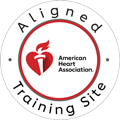[vc_row][vc_column width=”2/3″][vc_column_text]
Aortic valve stenosis (also called aortic stenosis or AS) is a condition where the heart’s aortic value has narrowed. This narrowing causes blood flowing from the left ventricle to the aorta and arteries to be impeded. It is estimated that up to 1.5 million people in the United States- with 500,000 of those being severe cases of AS. Aortic stenosis in some cases can lead to heart failure and sudden death.
There are three known causes of AS- progressive congenital wear and tear of a bicuspid valve, deterioration of the aortic valve in elderly people, and scarring of the aortic valve caused by rheumatic fever as a young adult or child. A bicuspid valve is the most common cause of AS. Because there is only two cusps instead of the usual three they cannot open as widely and blood flow is less controlled, the lack of control leads to more wear and tear on the leaflets. The increased wear and tear leads to scarring, lessened mobility, and calcification of the valve leaflets. In patients over age 65, protein collagen in the leaflets is lost and calcium deposits on them, this is called “senile calcific aortic stenosis.” When the mobility of the leaflets is decreased by calcium it causes thickening and scarring occurs, leading to AS. Unlike other heart conditions related to calcium deposits, this isn’t increased by unhealthy lifestyle choices. The third cause of aortic stenosis is damage from rheumatic fever. Rheumatic fever, caused by streptococcal bacteria, damages the valve leaflets themselves by making the edges of the leaflets fuse together. Rheumatic aortic stenosis is uncommon in the United States.
Common symptoms of aortic stenosis are chest pain, breathlessness, fainting, and palpitations. In rare cases the first and only symptom is sudden death. One-third of patients experience chest pain first, and over 50 percent report it as the condition progresses. This chest pain is caused by the higher pressure needed to pump blood through the damaged aortic valve and oxygen demand of the thickened muscle. During excitement and exercise, fainting can be a symptom of AS because of vasodilation leading to lowered blood pressure. With the damaged aortic valve the heart has trouble keeping up with the blood pressure drop, leading the patient to faint. It is believed that after the onset of chest pain and fainting life expectancy is less than three years without treatment. Shortness of breath due to heart failure is thought to be the most worrying sign of aortic stenosis. During the beginning of the condition it only happens during high levels of activity and decreases when resting. In later stages of aortic valve stenosis shortness of breath can even happen during rest, especially when lying flat. Life expectancy is only 6 to 24 months after this sets in.
Aortic valve stenosis is diagnosed and evaluated in four ways. An electrocardiogram can show odd arrangement of the heart’s electrical activity, which may reveal thickened muscle of the heart and lead to a diagnosis. An echocardiography obtains images of heart chambers and valves, showing the damaged valve. Thirdly, using a chest x-ray shows a dilated aortic valve. The most reputable method of diagnosing AS is cardiac catheterization. This measures the pressure on both sides of the valve and that can be used to determine valve area.
Treatment of aortic stenosis depends on the severity of the condition. In cases where the patient experiences little to no symptoms, a doctor will only monitor because surgery would be riskier than the condition itself. In mild cases, or with patients who aren’t able to receive surgery, balloon valvuloplasty can temporarily relieve AS. If severe AS is found, aortic valve replacement, either mechanical or bio-prostheses (from pigs or cows) is the usual treatment.
As with many diseases, the most important thing for patients with aortic valve stenosis is careful monitoring. Many people with this condition can live to fulfilling lives. Research continues to improve lives of the people diagnosed with this disease and increase life expectancy of patients.
Call Us Now
Get the Best CPR Class in Tampa Today!
References:
http://www.mayoclinic.org/diseases-conditions/aortic-stenosis/basics/definition/con-20026329 (Mayo Clinic)
http://www.medicinenet.com/aortic_stenosis/page4.htm (Medicine Net)
http://www.heart.org/HEARTORG/Conditions/More/HeartValveProblemsandDisease/Problem-Aortic-Valve-Stenosis_UCM_450437_Article.jsp (American Heart Association)
http://www.webmd.com/heart-disease/tc/aortic-valve-stenosis-overview (WedMD)
[/vc_column_text][/vc_column][vc_column width=”1/3″][vc_single_image image=”9789″ img_size=”medium” alignment=”center”][vc_single_image image=”6623″ img_size=”medium” alignment=”center”][vc_single_image image=”6529″ img_size=”medium” alignment=”center”][vc_single_image image=”6621″ img_size=”large” alignment=”center”][vc_single_image image=”6625″ img_size=”large” alignment=”center”][vc_single_image image=”6626″ img_size=”medium” alignment=”center”][vc_single_image image=”6523″ img_size=”medium” alignment=”center” onclick=”custom_link” link=”https://cprtampa.training/cpr-tampa-class-reviews-tampa-florida/”][vc_single_image image=”6655″ img_size=”medium” alignment=”center”][/vc_column][/vc_row]


